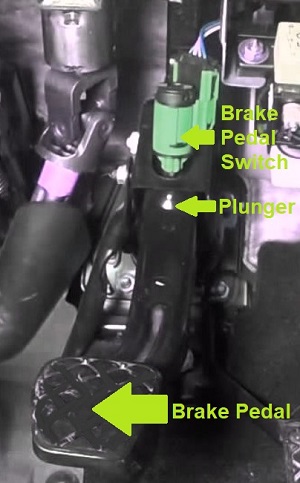![]()
How to Test a Brake Light Switch? [2 Tests]
DISCLAIMER: AS AN AMAZON ASSOCIATE I EARN FROM QUALIFYING PURCHASES. THIS POST CONTAINS AFFILIATE LINKS THAT WILL REWARD ME MONETARILY OR OTHERWISE WHEN YOU USE THEM TO MAKE QUALIFYING PURCHASES. FOR MORE INFORMATION, PLEASE READ MY EARNINGS DISCLAIMER.
|
The brake light switch is designed to sense if the brake pedal has been pressed. It also activates the brake lights when the brake pedal is down and deactivates them when you take your foot off the pedal.
Testing your brake light switch is really easy. You can do it with a digital multimeter or, if you don’t have one, you can build a simple circuit to check if the electrical current is flowing through the switch when it’s supposed to be on.
Test #1: Multimeter
This is how you test your brake light switch with a digital multimeter. All you have to do is to set your multimeter to “Ohm meter” (Ω), connect each of the two probes to the terminals of the brake light switch and check if the readings change when the plunger is ON or OFF:

If the reading keeps at 1 or OL, then the brake light switch is broken. If your digital multimeter has the “continuity check” function, turn it on, and with the probes connected to the terminals of the brake light switch, press the plunger and depress it.
If you don’t hear the characteristic “beep” that your multimeter makes when it finds continuity, then, again, the brake light switch is not working.
Test #2: Light bulb
If you don’t have a digital multimeter, you can build a circuit like the one shown below:

If the light doesn’t turn on when you press or depress the plunger, your brake light switch is defective.
This is a testing method for 2 pin brake light switches. If you have a 4 pin brake light switch, the testing is performed in the same way, but you just need to know the pinout of the switch to know which terminals you have to probe.
Here is a video on how you can check for continuity in a 4 pin brake light switch:
If you don’t have the pinout, you can google for it and if you are still unsure, you can try probing all the possible combinations. No harm will be done to your brake light switch if you do this.
What a brake light switch does
It is very important that your car’s brake light switch works fine. Why? Because having a defective brake light switch can be dangerous in many ways.
The first (and obvious) reason is that you will be running your car without the brake lights, which will make it difficult for the other drivers to determine if you are slowing down or not. But this is not the only problem that you could be facing with a broken brake light switch.
In modern cars that are equipped with many features like ABS, stability control, cruise control, automatic transmission, or adaptive suspension, the brake light switch also sends a signal to those modules to “let them know” if the brakes are active so they can act correspondingly. For example, if cruise control is set at a specified speed, it will be disengaged when the brakes of the car are activated.
If your car has any of the above-mentioned features, you could be getting an annoying warning light on your dashboard because of this problem. In a worst-case scenario, you could be thinking that everything is fine with your safety features like ABS or stability control, but they could be running in “emergency mode” or not functioning at all.
Fortunately enough, the solution to this problem is very simple and all you have to do is replace the brake light switch. It generally looks like this:

Sometimes you can try to clean it first, but most of them are sealed. You can’t open them unless you break them. You can try to spray some contact cleaner to the terminals and inside the switch. It won’t do any harm.
If you can’t clean it or it still doesn’t work, just get a new one! Brake light switches are not expensive and you can easily replace them by yourself.
But before cleaning or replacing the brake light switch do yourself a favor and check if this is the real problem by testing it with a multimeter as mentioned above. This will save you time and money in case your problem ends up being more complicated and the replacement does not solve the issue.
How a brake light switch works
The brake light switch has a plunger at one end and two of 4 terminals at the other end.

The plunger is at the brake pedal’s end and the contacts are on the opposite side. Inside a brake light switch, you literally have a switch.
Sometimes they can contain some simple electronics like a condenser or a filter to avoid electrical noise, but let’s assume that they are just a simple ON/OFF switch. There is also a spring that helps the plunger to return to its original position once the brake pedal has been released.
Depending on how a brake light switch is mounted on the car, the plunger will turn ON the switch when it is pressed or OFF when it is released. They are generally mounted so that they are at the OFF position when the plunger is pressed, and they switch to the ON position when the plunger is released. But this depends on the car manufacturer.
Here is a mechanic map (in case you need one):
Attention! This article is for informational purposes ONLY and is NOT a replacement for professional advice! ALWAYS consult your local specialist for an appropriate solution to your problem. All statements, prices, contact information, recommendations, and reviews contained herein came from sources that we believe to be reliable, but the accuracy or completeness thereof is not guaranteed. Please contact the service provider for complete details and updates.


